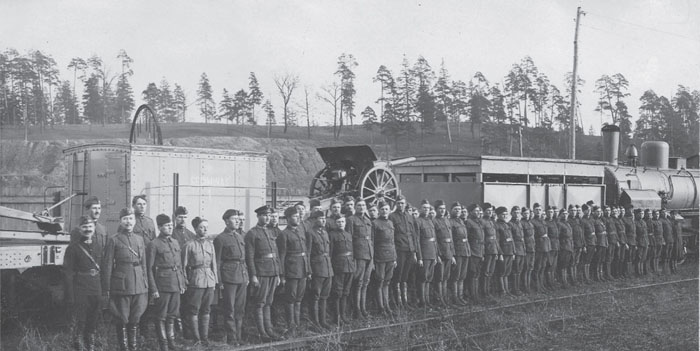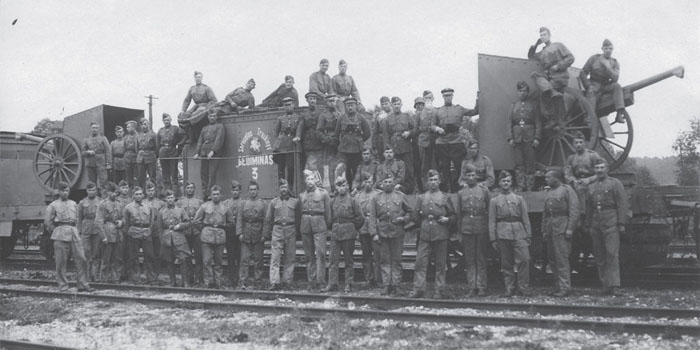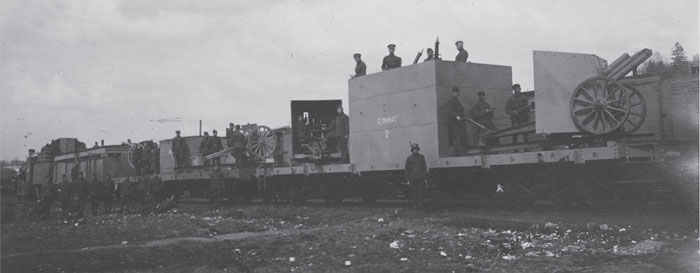
Lithuania waged three wars to gain its independence, beginning on 16 February 1918 and lasting for two years. The first was fought against the Bolsheviks, and ended in June 1919, the second against Russo-German forces invading Lithuania from neighbouring Latvia, and the third against the Polish Army which sought to seize Vilnius (Vilno) in defiance of the League of Nations’ decision to cede that city to Lithuania. This third conflict ended in defeat for the Lithuanians. The latter used two armoured trains,1 incorporating parts of captured Russian armoured trains.
The ST Gediminas2 was built in January 1920 in Kuanas (Kovno) and was despatched to Varena to confront the Poles. On the 19th of that month it was on the front line at Suvalkai, but was forced to withdraw to Vilnius, where it was captured intact by the Poles. It saw further service as part of the Polish armoured train PP 1 Marzalek.
In October 1920 a replacement armoured train bearing the name Gediminas was built by the Lithuanians. On 21 November it was sent to Kedainai to confront the Polish forces, but the ceasefire took effect before it could go into action.
When the Lithunian army was formally established, it included a battalion with three armoured trains, all built at the Kaunas workshops: ST 1 Gediminas, ST 2 Kęstutis3 and ST 3 Algirdas.4 The layout of each train was standardised asd an engine, an artillery wagon with two guns, and two machine-gun wagons each armed with eight machine guns. In January 1924 the battalion became a regiment and was incorporated in the Armoured Group ‘Sarvuociu Rinkine’. However, ST 3 Algirdas was broken up in early 1927. A directive dated 16 November 1927 fixed the establishment of the armoured trains as five officers, six NCOs and forty-one men. The armoured trains formation was finally dissolved on 14 August 1935. Certain sources give the name of the third armoured train as Glezininku Vilkas,5 but at the date of writing we have been unable to confirm or refute this. Several wagons survived to be captured during the Soviet invasion, but they have not been identified as having been incorporated in later Russian armoured trains.

Artillery Wagon No 1 of ST Gediminas, armed with a pair of ex-German 7.7cm Feldkanone 16 field guns, retaining their original shields. The mixed armament reflects the tortuous frontier problems of this period of European upheaval.
(Photo: Paul Malmassari Collection)

Artillery Wagon No 3 of ST Gediminas, armed with French 75mm Model 97 guns, again retaining their wheels but now fitted with large box gunshields.
(Photo: Paul Malmassari Collection)

In the foreground is Artillery Wagon No 2 of the ST Gediminas, armed with ex-German Army 10.5cm Leichte Feldhaubitze 98/09. The light howitzers, retaining their wheels, appear to be mounted on turntables. Each gun has been retrofitted with a large box shield providing good protection for the gunners. Artillery Wagon No 3 in the centre is armed with a pair of French 75mm Model 97 field guns with their wheels and original small shields.
(Photo: Paul Malmassari Collection)
1. In Lithuanian: ‘sarvuotas traukinys’, abbreviated to ‘ST’.
2. Gediminas (c. 1297–1341), Grand Duke of Lithuania in 1316.
3. Kęstutis (1297–1382), son of Gediminas, Duke of Trakai, co-ruler of Lithuania with his brother Algirdas.
4. Algirdas (c. 1276–1377), brother of Kęstutis, Grand Duke of Lithuania 1345.
5. ‘Iron Wolf’.